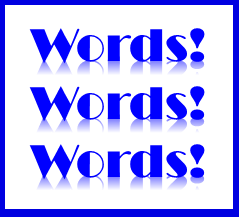 Last week’s post was only the beginning of an even longer list of common mistakes writers are prone to make. Below are a few more common mistakes you should remember the next time you’re writing something, so you can fix them before you share or publish your final draft.
Last week’s post was only the beginning of an even longer list of common mistakes writers are prone to make. Below are a few more common mistakes you should remember the next time you’re writing something, so you can fix them before you share or publish your final draft.
“Which” vs. “That”
"That" indicates a restrictive clause, and "which" indicates a non-restrictive clause (usually surrounded by commas); therefore, they cannot always be used interchangeably.
Examples:
Ballpoint pens, which are more precise, are less messy.
I don’t like cars that only have two seats.
Remember, it's always possible to delete a “which” clause from a sentence without changing its meaning. The same is not always the case for clauses with “that.”
“Who” vs. “That”
When “who” is used as a relative pronoun, it should be referring to people. And when “that” is used as a relative pronoun, it should be referring to things.
Examples:
Incorrect: That’s the man that built this shed.
Correct: That’s the man who built this shed.
If you need to fix this error in your writing, ask yourself if the relative pronoun you’re using is referring to a person or a thing. If it is a person or group of persons (sometimes even to a company or club or committee), then use “who”; if it’s a thing, then use “that.”
Me, Myself, and I
Writers often confuse how they should refer to themselves when other people are mentioned in the same sentence. The easiest way to avoid using the wrong word is to remove the other names from the sentence to see if it still makes sense to your ear. For example, if the original sentence is “The doctor met with Susan and me,” using “me” would be correct, because it would be troubling to the ear to say "The doctor met with I."
“Then” vs. “Than”
Recall that “than” is used in comparisons. (e.g., The blue pole is taller than the green pole.)
And “then” indicates time and a sequence of events. (e.g., He ate, then went for a walk.)
“Lay” vs. “Lie”
Typically, if you can use some variant of "put" or "place" instead in a sentence, use "lay." If not, use "lie." However, that only applies to sentences in the present tense. Don’t forget that “lay” is also the past tense of “lie,” so keep that in mind and memorize your table of tenses for “lie” to avoid this error.
Incorrect Modifiers
To avoid misplacing a modifier, you must place it directly next to the word it is modifying in a sentence.
Examples:
In the example below, “Charlie” is supposed to modify “dog.”
Incorrect: They adopted a dog for my brother they call Charlie.
Correct: They adopted a dog they call Charlie for my brother.
Dangling Modifiers
To prevent dangling modifiers, you should make sure your modifier has a subject. And most of the time, it should be placed next to the word it’s modifying.
Examples:
Incorrect: Impatient, the cookies were gobbled up before dinner.
Correct: The impatient children gobbled up the cookies before dinner.
Misspelled Homophones
When you’re unsure which homophone you want to use, look it up in the dictionary. Spellcheck won’t always pick up the version of the word you want to use.
Here are a few homophones that you should never misspell:
- you’re/your
- it’s/its
- their/there/they’re
- to/too/two
- complement/compliment
- forgo/forego
The fastest way to make your writing difficult to get through and understand is to fill it with errors that are easy to avoid. Be sure to bookmark this list of common writing mistakes, as well as those mentioned in last week’s post. They’ll help you avoid making simple writing errors.
Are there any other common writing mistakes you’d add to this list, or the list from last week? Please share them with us below.




